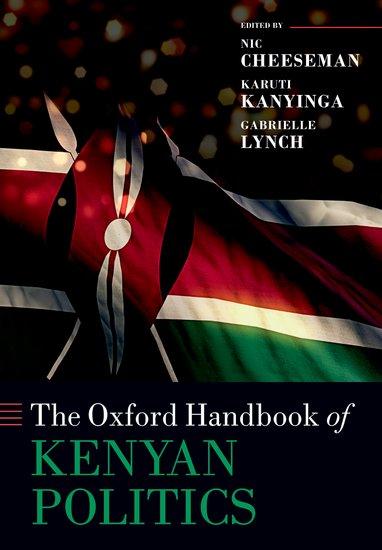
Zustellung: Do, 03.07. - Di, 08.07.
Versand in 3 Wochen
VersandkostenfreiThe Oxford Handbook of Kenyan Politics provides a comprehensive and comparative overview of the Kenyan political system as well as an insightful account of Kenyan history from 1930 to the present day.
Inhaltsverzeichnis
- Introduction
- 1: Nic Cheeseman, Karuti Kanyinga, and Gabrielle Lynch: The political economy of Kenya: Community, clientelism, and class
- Part I - The struggle for democracy
- 2: Derek R. Peterson: Colonial rule and the rise of African politics (1930-1964)
- 3: David W. Throup: Jomo Kenyatta and the creation of the Kenyan state (1963-1978)
- 4: David W. Throup: Daniel arap Moi and one-party rule (1978-1991)
- 5: Raymond Muhula: The limits of multipartyism (1992-2005)
- 6: James D. Long: Civil conflict, power sharing, truth and reconciliation (2005-2013)
- 7: Collins Odote: The 2013 elections and the peace narrative (2013-2015)
- 8: Marie-Emmanuelle Pommerolle: The 2017 elections and electoral (in)justice (2015-2017)
- Part II - Identity politics
- 9: John Lonsdale: Race and ethnicity in colonial Kenya
- 10: Gregory Deacon: The political role of Christian churches
- 11: Ngala Chome: The political role of Islam
- 12: Winnie Mitullah: Gender mainstreaming and the campaign for equality
- 13: Naomi van Stapele: Youth and masculinity
- 14: Sini Hassinen: Sexual minority rights and activism
- Part III - Political institutions
- 15: Yash Ghai: Constitutions and constitutionalism
- 16: Walter O. Oyugi and Jimmy O. Ochieng: The politics of the Provincial Administration
- 17: Ken Opalo: The rise and fall of the legislature
- 18: Michelle D'Arcy: Devolution and county government
- Part IV - Civil society, the media and political culture
- 19: Angelique Haugerud, Meghan Ference, and Dillon J. Mahoney: Satire, social media, and cultures of resistance
- 20: Denis Galava: The role of traditional media
- 21: Michelle Osborn: Chiefs, elders, and traditional authority
- 22: Geoffrey Lugano: Civil society and the state
- 23: Thomas P. Wolf: The science, suspicion and sustainability of opinion polls
- Part V - Political parties and strategies of mobilisation
- 24: Susanne D. Mueller: High stakes ethnic politics
- 25: Adams Oloo: The weaknesses of political parties
- 26: Sarah Jenkins: Violence as an election strategy
- Part VI - Law and (dis)order
- 27: Irina Ichim: The protection and promotion of human rights
- 28: Ambreena Manji: Land rights and the rule of law
- 29: Musambayi Katumanga: Post-colonial state-military relations
- 30: Abduallahi Boru Halakhe: Police, reform, and counter-terrorism
- 31: Jacob Rasmussen: Gangs and vigilantism
- Part VII - The political economy of development
- 32: John W. Harbeson and Frank Holmquist: The lessons and legacies of the "Kenya debate''
- 33: Radha Upadhyaya and Edoardo Totolo: The financial sector
- 34: Mai Hassan: The local politics of resource distribution
- 35: Bitange Ndemo and Dennis Aiko: Mobile technology and development
- 36: Jennifer N. Brass: NGOs and public service provision
- 37: Jane N.O. Khayesi: The informal economy and its relationship with the state
- Part VIII - Kenya and the world
- 38: Michael Chege: The political economy of foreign aid to Kenya
- 39: Njoki Wamai: International relations and the International Criminal Court
- 40: David M. Anderson: Kenya's war in Somalia
- 41: L. Muthoni Wanyeki: Foreign policy and regional relations
- 42: Samuel M. Makinda: The rise of China in Kenya's foreign relations
- Part IX - Regional politics in the time of devolution
- 43: Patrick O. Asingo: Nyanza: The Odinga dynasty and beyond
- 44: Peris S. Jones: Nairobi: The politics of the capital
- 45: Alex Dyzenhaus: Rift Valley: The struggle for supremacy
- 46: Hassan H. Kochore: North Eastern: From the periphery to the center
- 47: Dominic Burbidge and Thomas Raji: Central: Self-sufficiency in a local arena
- 48: Frederick O. Wanyama: Western: Negotiating political heterogeneity
- 49: Mumo Nzau: Eastern: The dynamics of "bridesmaid politics"
- 50: Hannah Waddilove: The Coast: An elusive political bloc
Mehr aus dieser Reihe
Produktdetails
Erscheinungsdatum
10. Februar 2023
Sprache
englisch
Seitenanzahl
800
Reihe
Oxford Handbooks
Herausgegeben von
Nic Cheeseman, Karuti Kanyinga, Gabrielle Lynch
Verlag/Hersteller
Produktart
kartoniert
Gewicht
1383 g
Größe (L/B/H)
241/183/61 mm
ISBN
9780192887429
Entdecken Sie mehr
Bewertungen
0 Bewertungen
Es wurden noch keine Bewertungen abgegeben. Schreiben Sie die erste Bewertung zu "The Oxford Handbook of Kenyan Politics" und helfen Sie damit anderen bei der Kaufentscheidung.
































